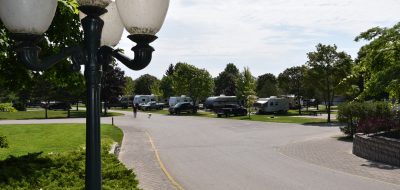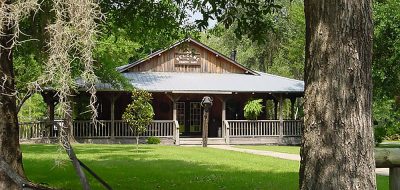OUTSIDE TASKS
NOTE
Perform sewer system steps if needed.
If sewer hookup is not available, move trailer to the RV sewage dump station before leaving RV Park. (If needed) Drain & flush sewage and wastewater tanks at the RV Park dump station.
CAUTION
Health Hazard
You should wear disposable latex rubber gloves or nitrile gloves while handling the sewage discharge hose. Recommend washing your hands when this task is finished.
1. Verify sewage discharge hose is connected between trailer sewage outlet pipe and RV Park sewer system.
2. Verify main wastewater tank drain valve is closed.
3. Verify galley wastewater tank drain valve is closed
4. Open sewage waste tank drain valve.
5. Drain sewage waste tank.
6. Open campsite hookup water valve to flush hose.
7. Flush sewage waste tank for about three minutes.
8. campsite hookup water valve to flush hose.
9. Close sewage waste tank drain valve.
10. Open main wastewater tank drain valve.
11. Drain main wastewater tank.
12. Close main wastewater tank drain valve.
13. Open galley wastewater tank drain valve.
14. Drain galley wastewater tank.
15. Close galley wastewater tank drain valve.
16. Disconnect flush hose from trailer sewage tank San-T-Flush water hose connection.
17. Connect flush hose to hose connection on clear 90-degree elbow at sewage outlet.
18. Open hose valve on clear 90-degree elbow at sewage outlet.
19. Open campsite hookup water valve to flush hose.
20. Flush sewage outlet piping and discharge hose for about two minutes.
21. Close campsite hookup water valve to flush hose.
22. Close hose water valve on clear 90-degree elbow at sewage outlet.
23. Disconnect flush hose from hose connection on clear 90-degree elbow at sewage outlet.
24. Disconnect sewage discharge hose from campsite sewer hookup.
25. Place cover on campsite sewer hookup.
26. Remove & stow red sewage adapter from sewage discharge hose.
27. Disconnect sewage discharge hose from clear 90-degree elbow.
28. Stow sewage discharge hose.
29. Remove & stow clear 90-degree elbow from trailer sewage outlet pipe.
30. Attach cap to trailer sewage outlet pipe.
31. Fill fresh water tank, if needed.
32. If open, close vent valve to fresh water tank.
NOTE
Perform water system steps if needed.
33. Disconnect & stow fresh water hose.
34. Disconnect & stow flush hose.
35. Verify water system compartment lamp is OFF.
36. Close & lock water system compartment door.
37. Remove & stow foam rubber bumpers from lower edges of bedroom slider.
38. Disconnect & stow TV cable. (If used)
39. Disconnect & stow the telephone cable. (If used)
WARNING
NEVER travel with propane tank valves open.
40. Close tank valves on both propane tanks. (If used)
41. Retract and secure all awnings for travel. (If used)
INSIDE TASKS
42. Verify washer/dryer unit is OFF.
43. Verify furnace is OFF.
44. Verify water heater is OFF.
45. Verify air conditioners are OFF.
46. Verify air purifier is OFF.
47. Verify water pump is OFF.
48. Close all windows.
49. Prepare inside of trailer for retracting slider units for travel.
CAUTION
Let everyone at your campsite know that you are about to move the slider units before operating them to prevent personnel injuries.
50. Verify foam rubber bumpers on lower edges of bedroom slider are removed.
51. Move bedroom slider unit to the CLOSED position for travel.
52. Move the living room slider unit to the CLOSED position for travel.
53. Crank down TV antenna to the travel position. (If used)
54. Secure all loose items and furniture for travel.
55. Verify all cabinet doors are closed.
56. Secure shower door for travel.
57. Secure all sliding/folding doors for travel.
58. Close bedroom closet doors.
59. Turn off all interior trailer lights.
OUTSIDE TASKS
WARNING
Never disconnect the electric power cable with campsite electric hookup circuit breakers turned on. Personnel injury may result if circuit breakers are ON during electric power cable hookup.
60. Set circuit breakers to OFF in campsite electric hookup panel.
61. Disconnect & stow electric power cable.
62. Remove and stow trailer wheel locks.
INSIDE TASKS
63. Move pets to truck for travel.
64. Verify all trailer interior lights are OFF.
65. Verify all trailer windows are closed.
66. Verify everything inside trailer is secured for travel.
67. Verify the refrigerator doors are closed for travel.
68. If desired for refrigerator operation, set the refrigerator Power Switch to the ON position. (Press & hold in the ON button for about three seconds.)
69. If desired for refrigerator operation, set the refrigerator Mode Switch to the AUTO position.
OUTSIDE TASKS
70. Close & lock trailer door.
71. Put handrail in travel position.
72. Put doorsteps up into travel position.
73. Check all around campsite and under trailer for any items not put away or disconnected.
74. Verify all trailer storage compartment doors are closed & locked.
75. Perform an operations check of truck and trailer lights.
WARNING
Do not move trailer if trailer brakes fail to operate.
76. Test trailer brakes with Electric Brake Controller as follows:
- Start truck engine
- Disengage truck emergency brake
- Apply trailer brakes with switch on brake controller
- Attempt to drive truck forward
- Trailer brakes should keep trailer & truck from moving
- If trailer brakes fail to operate, have trailer brakes repaired by a qualified mechanic
- Release trailer brake controller switch
- Trailer brakes should allow truck & trailer to move
77. Test the Breakaway System as follows:
- Pull out Breakaway switch pin that is attached to a cable
- This activates trailer electric brakes
- Attempt to drive forward
- If Breakaway systems is operating properly, trailer wheels should not rotate
- If trailer wheels rotate, have trailer brakes repaired by a qualified mechanic
- Insert pin back into Breakaway switch
- Attempt to drive forward
- Trailer wheels should rotate
We thank author, Lester Evans for this checklist.
Happy Camping,
Fred b.






Gary
Good List – I have mine in the console in the truck. Sometimes stuff just happens – it never hurts to check your list before you put it in gear. When we think about what most of us are doing – we drove a car or a pickup forever. Now we have the responsibility for the biggest rig we will ever drive – not much training and in most states not even a CDL in our pocket. That is enough stress – why would anyone want to forget to retract the steps… Keep and expand the list to meet your own needs. Happy and safe travels.
Jim Autry
OH…..I forgot…. A really quick way to check the lights if traveling alone:
After you’re all hooked up, turn on your parking lights and your 4-ways. Then do a walk around.
Jim Autry
Thanks for sharing Fred. I, for one, think we all need an occasional reminder of the basics.
One thing I would do differently, especially if you don’t have a spray/rinse system for your holding tanks. Empty them when you arrive at your next overnight stop. That way the road movement of your RV will mix up your “load” and help keep deposits from building up inside, , black tank first of course. Or take an extra moment at free dump stations provided by your larger fuel/truck stops and at many rest areas.
Randy Patton
I agree this is list is long and includes many items that seen like common sense, but ……, try not doing any of them and the results can be “a very bad day”. Modify the list if you must, but use a list!
See you on the road!
Chet Atkisson
That is indeed a great checklist but I don’t quite agree with step # 40. My Alpenlite fifth wheel only has a two way refrig/freezer so it would be quite difficult to maintain proper temps in it with the propane shut off and no 120 volt power available while traveling.
Patrick W. Tribbey
Good list and reminders. Ever loose the TV antenna simply ’cause someone FORGOT?? I have posted a very short list in our TT/camper just simply as a REMINDER—-I can’t remember everything! Won’t necessarilly need TV antenna after today, anyhow! (6/12/09). I check and my wife asks me about this, that, or the other just to make sure I haven’t FORGOTTEN anything!
Will suggest that a light check, (brake, parking, turnsignals), be added.
H A P P Y C A M P I N G, everyone! 🙂
sandy
Being new to RVing, it’s refreshing to see a back to basics comment. So many of the comments assume you know things that you don’t. If you are experienced enough, then ignore but some of us are starting at zero.
Magsteer
Sorry, this check list is ridiculous: It makes it sound like RVing takes a PhD in mechanical engineering. One camping trip, and most of us have it down pat; 90 percent, or more, is common sense. These lists are so intimidating it’s ludicrous.
Larry D. Megenhardt
You state: You should wear disposable latex rubber gloves or nitrile gloves while handling the sewage discharge hose. Recommend washing your hands when this task is finished.
Why not?